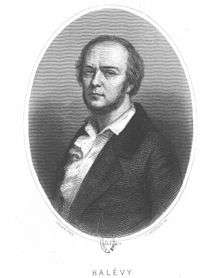Guido et Ginevra
| Fromental Halévy |
|---|
 |
|
Operas
|
Guido et Ginevra, ou La Peste de Florence (French: Guido and Ginevra, or the Plague at Florence) is a grand opera in five acts by Fromental Halévy to a libretto by Eugène Scribe. It was premiered on 5 March 1838 by the Paris Opera at the Salle Le Peletier.
Performance history
Guido et Ginevra was only a moderate success for Halévy, not nearly as applauded as his previous grand opera La Juive (1835) or as La reine de Chypre which followed it (1841). However, after its premiere it was soon played in all the major European centres. When the opera was revived in Paris in 1840 it was cut to four acts. It was translated into Italian and performed in three acts by the Théâtre-Italien at the Salle Ventadour beginning on 17 February 1870.[1] It was performed in German in Mannheim beginning on 3 April 1879, and Hamburg, on 20 March 1882.[2] No recent productions are known.
The opera contains touches of the composer's innovative orchestration, with a melophone in Act II, and with Ginevra's tomb scene set to dark woodwind and brass instruments using diminished harmonies.
Roles
| Role | Voice type | Premiere Cast,[3] 5 March 1838 (Conductor: ) |
|---|---|---|
| Cosme de Médicis | bass | Nicolas Levasseur |
| Manfredi, Duke of Ferrara | bass | Nicolas-Prosper Dérivis |
| Guido, a young sculptor | tenor | Gilbert Duprez |
| Forte-Braccio, condottiere | tenor | Jean-Étienne-Auguste Massol |
| Lorenzo, steward to Médicis | bass | Molinier |
| Téobaldo, sacristan of Florence Cathedral | bass | Ferdinand Prévost |
| Ginevra, daughter of Médicis | soprano | Julie Aimée Dorus-Gras |
| Ricciarda, a singer | mezzo-soprano | Rosine Stoltz |
| Léonore, chambermaid of Ginevra | soprano | Mme Morin |
| Antonietta, young peasant | soprano | Maria Flécheux |
Synopsis
Scribe drew the elements of his plot from the history of Florence by Louis-Charles Delécluze
Act 1
The Medici court
Ginevra is to be married to the Duke of Ferrara.
Act 2
During the ceremony, a poisoned veil she has been given causes her to faint away in a deathlike trance; the sculptor Guido mourns her. It is assumed that she has the plague.
Act 3
The Medici vault
Buried in the Medici vault she awakes.
Act 4
Guido offers her shelter.
Act 5
The village of Camaldoli
Ginevra is reunited with her father, who agrees to her marriage with Guido. A procession of thanksgiving ends the opera.
References
Notes
- ↑ Loewenberg 1978, column795; Chouquet 1873, p. 400; see also OCLC 459206797.
- ↑ Loewenberg 1978, column795.
- ↑ Casaglia, Gherardo (2005).[http://www.amadeusonline.net/almanacco?r=&alm_giorno=05&alm_mese=03&alm_anno=1838&alm_testo=Guido_et_Ginevra "Guido et Ginevra, 5 March 1838"]. Almanacco Amadeus (Italian).
Sources
- Chouquet, Gustave (1873). Histoire de la musique dramatique en France (in French), pp. 309–425. Paris: Didot. View at Google Books.
- Hallman, Diana (2003). "The Grand Operas of Fromental Halévy", in The Cambridge Companion to Grand Opera, ed. David Charlton.
- Loewenberg, Alfred (1978). Annals of Opera 1597–1940 (third edition, revised). Totowa, New Jersey: Rowman and Littlefield. ISBN 978-0-87471-851-5.
- Macdonald, Hugh (2001). Guido et Ginevra, article in Grove Music Online.